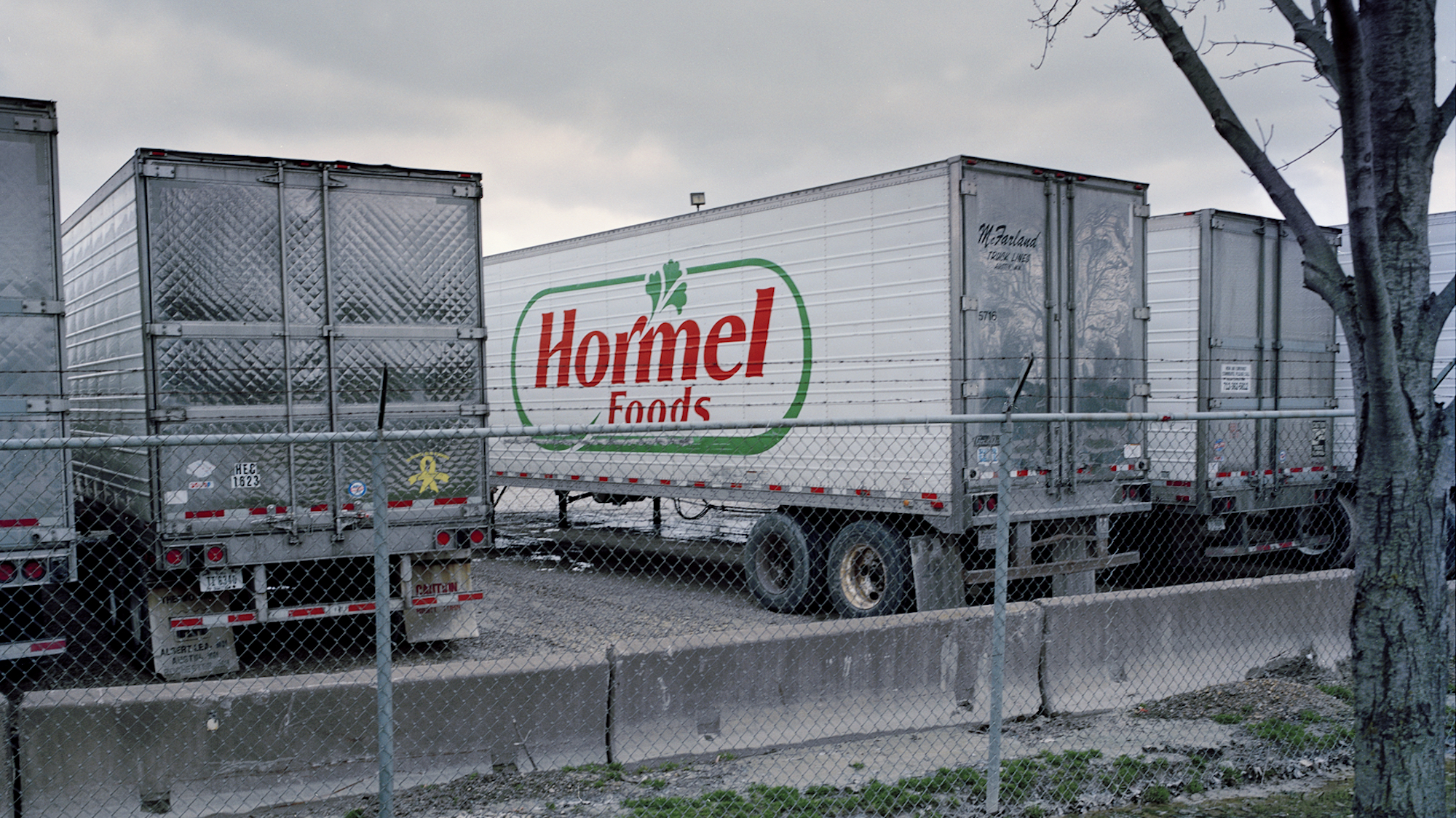On the cut-and-kill floor of Quality Pork Processors Inc. in Austin, Minnesota, the wind always blows. From the open doors at the docks where drivers unload massive trailers of screeching pigs, through to the “warm room” where the hogs are butchered, to the plastic-draped breezeway where the parts are handed over to Hormel for packaging, the air gusts and swirls, whistling through the plant like the current in a canyon. In the first week of December 2006, Matthew Garcia felt feverish and chilled on the blustery production floor. He fought stabbing back pains and nausea, but he figured it was just the flu—and he was determined to tough it out.
Garcia had gotten on at QPP only 12 weeks before and had been stuck with one of the worst spots on the line: running a device known simply as the “brain machine”—the last stop on a conveyor line snaking down the middle of a J-shaped bench [DC] called the “head table.” Every hour, more than 1,300 severed pork heads go sliding along the belt. Workers slice off the ears, clip the snouts, chisel the cheek meat.
They scoop out the eyes, carve out the tongue, and scrape the palate meat from the roofs of mouths. Because, famously, all parts of a pig are edible (“everything but the squeal,” wisdom goes), nothing is wasted. A woman next to Garcia would carve meat off the back of each head before letting the denuded skull slide down the conveyor and through an opening in a plexiglass shield.

Matthew Garcia.
Alec Soth/Magnum Photos
On the other side, Garcia inserted the metal nozzle of a 90-pounds-per-square-inch compressed-air hose and blasted the pigs’ brains into a pink slurry. One head every three seconds. A high-pressure burst, a fine rosy mist, and the slosh of brains slipping through a drain hole into a catch bucket. (Some workers say the goo looked like Pepto-Bismol; others describe it as more like a lumpy strawberry milkshake.) When the 10-pound barrel was filled, another worker would come to take the brains for shipping to Asia, where they are used as a thickener in stir-fry. Most days that fall, production was so fast that the air never cleared between blasts, and the mist would slick workers at the head table in a grisly mix of brains and blood and grease.
Tasks at the head table are literally numbing. The steady hum of the automatic Whizard knives gives many workers carpal tunnel syndrome. And all you have to do is wait in the parking lot at shift change to see the shambling gait that comes from standing in one spot all day on the line. For eight hours, Garcia stood, slipping heads onto the brain machine’s nozzle, pouring the glop into the drain, then dropping the empty skulls down a chute.
Click on the links labeled “[DC]” to explore primary sources using DocumentCloud’s suite of investigative tools.
And then, as the global economy hit the skids and demand for cheap meat skyrocketed, QPP pushed for more and more overtime. By early December, Garcia would return home spent, his back and head throbbing. But this was more than ordinary exhaustion or some winter virus. On December 11, Garcia awoke to find he couldn’t walk. His legs felt dead, paralyzed. His family rushed him to the Austin Medical Center, not far from the subdivided Victorian they rented on Third Street. Doctors there sent Garcia to the Mayo Clinic in Rochester, about an hour away. By the time he arrived, he was running a high fever and complaining of piercing headaches. He underwent a battery of exams, including MRIs of his head and back. Every test revealed neurological abnormalities, most importantly a severe spinal-cord inflammation, apparently caused by an autoimmune response. It was as if his body was attacking his nerves.
By Christmas, Garcia had been bedridden for two weeks, and baffled doctors feared he might be suicidal. They sent a psychiatrist to prepare him for life in a wheelchair.
There is no Matthew Garcia.
Or, rather, Matthew Garcia is not his name. It’s the made-up name I’ve given him to shield him from Immigration and Customs Enforcement. I don’t know his real name anyway, not the name his mother cooed when she cradled him in her arms. All I know is the name on his driver’s license, his I-9 and ITIN, his medical records and workers’ comp claim. There is no Matthew Garcia in Austin, Minnesota, and if you go looking, you won’t find him, but then there’s no Emiliano Ballesta or Miriam Angeles either. Not really. Because many QPP employees are working under a fake name with false papers and a phony address.
And not just the people on the kill floor. You see: QPP is simply another way of saying Hormel and its corporate headquarters in Dallas is just a tax-accounting firm in a poured-concrete office park along the LBJ Freeway. And if you leaf through the Austin phone book, you can find a listing for Kelly Wadding, the CEO of QPP, but if you drive there, you’ll find no house, no such address.
In Austin, such half-truths and agreed-upon lies are as much a part of the landscape as the slow-moving Cedar River. On one bank stands the Hormel plant, with its towering six-story hydrostatic Spam cooker and sprawling fenced compound, encompassing QPP and shielded from view by a 15-foot privacy wall. When I asked for a look inside, I got a chipper email from the spokeswoman: “They are state-of-the-art facilities (nothing to be squeamish about!) but media tours are not available.” On the other bank is the Spam Museum, where former plant workers serve as Spambassadors, and the sanitized history of Hormel unfolds in more than 16,000 square feet of exhibits, artifacts, and tchotchkes.
One room is done up as the Provision Market, opened by George Hormel (pronounced HOR-mel to rhyme with “normal”) in the Litchfield Building on Mill Street in November 1891. But the company we know today—and its most famous product—didn’t emerge until after Hormel’s son, Jay, took over in 1929. Jay Hormel was a masterful manager and a gambler in the true capitalist sense. In the trough of the Great Depression, he bet Americans would buy into the idea of low-cost canned dinners. Hormel chili, Dinty Moore stew, and Spam were born.
Around the same time, Hormel attempted to institute a progressive pension plan in which the company would contribute $1 to a worker’s 20 cents per week. But he didn’t bother pitching its benefits to employees; he simply instructed foremen to collect signatures—a style of leadership he later rued as “benevolent dictatorship.” Wary line workers refused, and when one gave in, labor organizers incited a work stoppage. Local business leaders panicked. Hormel urged them to accept union labor in Austin. “I am not going to get mixed up in a fight in my hometown,” he declared. But he was too late.
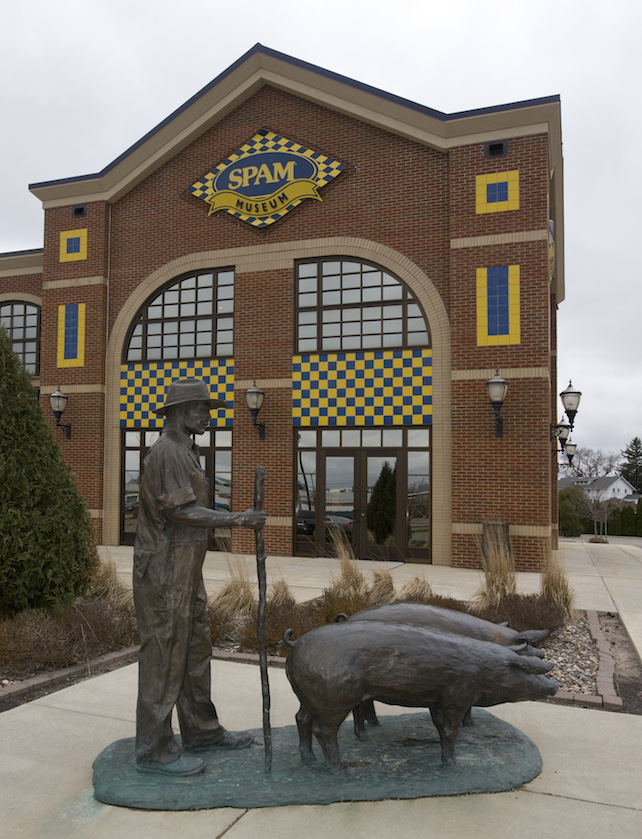
The Spam Museum.
Alec Soth/Magnum Photos
In November, poorly armed union organizers, dissatisfied with the slow progress of negotiations, escorted Hormel from the general offices and shut down the plant’s refrigeration system—threatening to spoil $3.6 million of meat. For three straight days, Hormel went to the picket line to address workers from an improvised platform and meet with union leaders. He brought the strike to a quick end by agreeing to a series of forward-looking incentives, including profit-sharing, merit pay, and the “Annual Wage Plan,” an unheard-of salary system in an industry dominated by piecework and hourly rates. Hormel also agreed that increases in output would result in more pay for workers, and he even guaranteed them 52 weeks’ notice prior to termination.
Fortune derided Hormel as the “red capitalist,” but the moves earned him a matchless period of management-labor cooperation and national goodwill. During World War II, the company cranked out K-rations, sending canned meat up supply lines across the Pacific and securing Spam acclaim as the “meat that won the war.” Hormel even created a “special workers” program, designed to assist veterans, in which up to 15 percent of the workforce could be given light duty if disabled. But all that started to change when the company passed out of family hands and fell under new corporate leadership that wasn’t interested in Jay Hormel’s progressive benefits. In 1975, future president Richard Knowlton began to negotiate an agreement that would build a whole new plant with the promise of reducing workloads—and allow him to gut longstanding incentive programs. That led to a bitter strike—and completed the transition from George A. Hormel & Co., the family business, to Hor-MEL, the corporation. But that era was about more than rebranding. It was the start of shell companies and shell games; this was when everyone learned to speak this local dialect of truth, when the cut-and-kill side of the operation became QPP, and the workforce became populated with undocumented immigrants working under false names.
It was February 2007, and the pipes under Emiliano Ballesta’s trailer home on the outskirts of Austin had frozen solid. Worried about his wife and five children—most of all, his five-year-old son, who had recently been diagnosed with leukemia—Ballesta shimmied into the crawl space with a pair of small kerosene heaters. Instead of thawing the pipes, he ignited the wispy insulation hanging from the floorboards, and, in no time, flames engulfed the place. When police and firemen arrived, black smoke was rolling from under the eaves. By morning, nothing remained but a blackened hull.
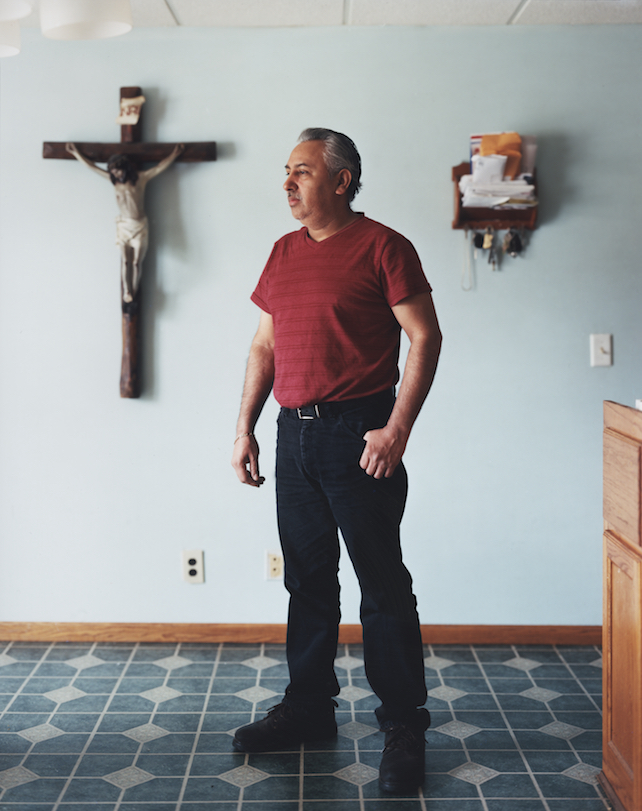
Emiliano Ballesta in the Queen of Angels church in Austin, Minnesota.
Alec Soth/Magnum Photos
The family slept on friends’ couches and floors for weeks after that. Despite 12 years of working at QPP’s head table, Ballesta was only making $12.75 an hour, barely a $26,500 base salary. But he had worked Saturdays for overtime as long as he could remember, and lately there were plenty of additional hours available as production ramped up to meet surging demand.
Spam, it turns out, is an excellent economic indicator. As the recession took hold, both Hormel and QPP offered more and more hours to workers. Hormel employees told the New York Times that they’d never seen so much overtime, and Hormel’s CEO, Jeffrey M. Ettinger, confirmed that sales figures were climbing by double digits. Though head meat goes into sausage, not Spam, the increased production of one item increases output of everything else. One Hormel worker told the Times he’d bought a new TV and refrigerator with his overtime hours; Emiliano Ballesta could afford to move his family into a rental home.
In May 2007, Ballesta was at a son’s high-school commencement when he noticed his legs starting to feel tight and numb. Within days, his right hip and thigh were throbbing, and it was as if the soles of his feet were on fire. At first, he chalked it up to fatigue, so many extra hours standing, but soon he was having trouble walking from the QPP parking lot to the plant door.
Ballesta wasn’t alone. Miriam Angeles, who worked near the head table removing remnants of spinal cords, had started having burning pain in her lower legs, too, and now her right arm had begun falling asleep—both at work and at home, when she tried to feed her infant daughter. Susan Kruse, who cleared neck meat from the foramen magnum—the aperture where the spinal cord enters the skull—had a knot in her left calf that wouldn’t go away. When the cramps spread to her right leg, and stiffness in her hands turned to tingling, Kruse finally went to the doctor. Even Pablo Ruiz, a process-control auditor who only passed by the head table, was starting to have numbness in his legs and once fell to the plant floor.
In the meantime, Mayo doctors had prescribed Matthew Garcia a steroid to calm his nerve inflammation, and he’d improved enough to get around without a walker. He had lost pelvic floor function, robbing him of bowel control, and had to catheterize himself, but he managed to return to the brain machine in May. Within three weeks, though, Garcia couldn’t stand again. Relatives rushed him back to the emergency room.
Dale Chidester, until recently the office coordinator of the United Food and Commercial Workers Local 9, is a bear of a man with unruly hair and a salt-and-pepper goatee, but he’s good-looking (he could be a ’70s action star gone to seed) and speaks in a sweet, soft rasp. We met in his office in the Austin Labor Center. The building’s institutional architecture, mostly reserved these days for elementary schools and county lockups, is like a time capsule of Depression-era proletarianism. Each morning, Chidester opened the window at the check counter, pushing up the wooden shutter as if it were a gate on a service elevator, and planted himself in his creaky office chair—a picture of FDR over one shoulder, a picture of Geronimo over the other.
The Head Cases
QPP workers diagnosed with an autoimmune disorder were clustered around the machine used to liquefy 1,350 pig brains every single hour.
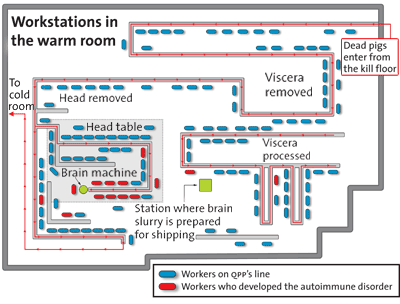
Chidester didn’t yet live in Austin during the 1985-86 strike—he worked at Hormel’s plant in Ottumwa, Iowa—but he remembers well the regular four-hour runs up I-35 to deliver supplies to the families struggling through those lean months. He started in meatpacking in the late ’70s, just as the country was sliding toward recession and all of the major meatpacking companies were consolidating and forcing workers to accept lower wages. Chidester says he witnessed a lot of dirty tricks meant to double-cross the unions. The Wilson Foods pork-processing plant in neighboring Albert Lea filed for bankruptcy in 1983 in order to nullify existing contracts and cut workers’ average pay from $10.69 an hour to $6.50. With improved margins, owners were able to sell the company at a sizable profit.
In Austin, the Packinghouse Workers Local 9 (P-9, as it was then known) bristled at talk of lower wages. Workers had already conceded too much in return for Richard Knowlton’s wan promise to build a state-of-the-art plant and keep Hormel’s full operation in Austin. He had convinced P-9 to give up the incentive pay system; freeze wages until the new plant was complete; and sign away the right to strike until three years after the plant opened. Knowlton had recognized that profit margins were vanishing from butchering as automation transformed the trade into increasingly monotonous, low-skill jobs.
There was no reason, in his mind, to pay union wages for cut-and-kill workers. Like a latter-day Jay Hormel, he saw the future in making a new generation of packaged meals that America’s increasingly female workforce could pop in the microwave at the end of the day. But, unlike Jay Hormel, Knowlton was reaching for increased profits (as well as a hefty bump in his own salary) by wresting away worker benefits. In October 1984, Knowlton demanded a 23 percent wage cut (PDF), from $10.69 an hour to $8.25. But under the strike restriction, P-9—which had just been absorbed into the United Food and Commercial Workers—had no recourse until August 1985.
When the no-strike period expired, P-9 walked out, beginning a 13-month strike that would stand among the most notorious and rancorous in American history. Believing that Hormel couldn’t compete against larger companies that had already brought union wages down to $8.25, the UFCW asked P-9 to accept the lower wages, so as to restore the pattern bargaining that had existed for decades, with a common wage scale across all companies and plants. When P-9 refused, and even organized a nationwide boycott of Hormel products, the UFCW sent a letter to every local in the AFL-CIO asking them not to support P-9. Strikers who crossed the picket line were joined by scabs, the windows of their cars pounded daily by outraged union members. Minnesota Gov. Rudy Perpich called in the National Guard to protect the scabs. Finally the UFCW ended the strike by putting P-9 into receivership and negotiating a 1-cent increase over the wages proposed by Hormel, along with a promise that strikers would be given preference for rehiring as scab-occupied positions were vacated.
Then, in November 1987, barely a year after the conditions of the strike resolution were made official, Hormel announced a shutdown of nearly half of the new plant. Hormel would continue to operate the packaging operation on the refrigerated (“cold”) side, but the cut-and-kill (“hot side”) would be taken over by Quality Pork Processors Inc. QPP then existed only on paper but was headed by Richard C. Knight, a former executive at Swift, the Chicago-based meatpacker that pioneered the conveyor line and had a major plant in nearby Albert Lea.
Knight claimed his new company would be separate from Hormel, though QPP would buy exclusively Hormel hogs and sell the butchered meat exclusively back to Hormel. They would use Hormel’s space and Hormel-owned equipment, rely on the Hormel mechanics, drive Hormel forklifts. The newly dubbed Local 9 felt this was a union-busting tactic and asserted that 550 former strikers still on the preferential recall list were entitled to the new jobs created by the subcontract—and at the wages the union had just agreed to, not the $6 to $8 an hour now being offered. Hormel denied this and, to make its point, erected a wall in the middle of the plant to divide Hormel from QPP. Eventually it would add a separate entrance and run a chain-link fence through the center of the parking lot. “It’s kind of like taking a room in the middle of a house,” Chidester told me, “and saying it’s not really part of the house.”*
Local 9’s attorney asked the St. Paul Pioneer Press: “What good is a union contract if the company can avoid the contract by simply leasing its premises to another company and get the work done at non-union rates?” On the first day of operation in June 1988, an arbitrator closed down QPP. It took a year of legal wrangling, but the union eventually conceded. The contract was amended to allow lower pay for subcontractors, and the plant reopened in June 1989. UFCW bosses hailed the deal as a victory, even though they had won an hourly wage of $9 at QPP after the local had gone on strike to protect a $10.69 hourly wage at Hormel. The two-tier pay scale that the old P-9 leadership had warned against had arrived—but cloaked in doubletalk. “It’s not a two-tiered wage,” Chidester explained with an ironic smile. “It’s just a subcontractor with a lower wage scale.”
*The courts haven’t bought the argument, either. In a 2001 class action [DC] brought by 700-plus employees who claimed they were owed wages for time spent cleaning and donning safety gear, the plaintiffs asked the judge to add Hormel as a “joint employer.” She agreed, nothing that, among other things, QPP executive salaries appear to be negotiated with Hormel, which is a $7.4 billion Fortune 500 company. QPP promptly settled for $1,075,000.
With new wages came new workers, and even rumors that QPP recruited laborers in Mexico. Matthew Garcia said he didn’t know of formal recruitment, but in his Oaxacan town of fewer than 1,000 residents, nearly every adult male he knew had, at one time or another, worked at QPP. By the early ’90s, Austin had gone from having a united local workforce to having a sharply divided workforce that, while still unionized, is, on the QPP side, decidedly less vocal and less powerful. By some estimates, QPP’s labor force today is 75 percent immigrant. But the anger of former strikers who had been promised preferential rehiring did not fall on QPP for its hiring practices; many townspeople turned on the immigrants themselves.
“It’s still leftover bitterness from the strike,” Chidester said, “because that strike was an unconditional surrender. You know, the company won.”

Many Austin locals say the town—devastated by the farm crisis as well as the strike—now depends on immigrants to survive, and they appreciate the cultural influx. Still, recently the Minutemen and a homegrown neo-Nazi group have held rallies in Austin; it’s become a regular stop-off for tea party activists. Police have followed Gov. Tim Pawlenty’s 2008 executive order (PDF) that effectively deputized local officers in enforcing federal immigration laws, and some in Austin have even advocated for ordinances like one passed by sister Hormel town Fremont, Nebraska, to force landlords and employers to run immigration background checks on prospective employees and tenants. At last year’s mayoral debates, the candidates—a former Austin police officer and a clerk at Hormel—agreed on only one thing: Illegal immigration was too complex to tackle just at the local level. By most counts, there are more than 5,000 Mexican immigrants living in Austin—about one-fifth of the town’s population—and Mayor Tom Stiehm, the former cop who won reelection, estimates that 75 percent are working under false identification.
Hormel’s calculated decision to divide itself has also divided Austin.
Since 1989, the line speed at QPP had been steadily increasing—from 750 heads per hour when the plant opened to 1,350 per hour in 2006, though the workforce barely increased. To speed production, the company installed a conveyor system and humming automatic knives throughout the plant, reducing skilled tasks to single motions. Workers say nearly everyone suffered from carpal tunnel syndrome or some repetitive stress injury, but by October 2007, there were signs of something else. Workers from QPP’s kill floor were coming to Carole Bower, the plant’s occupational health nurse, with increasingly familiar complaints: numbness and tingling in their extremities, chronic fatigue, searing skin pain. Bower started noticing workers so tender that they struggled with the stairs to the top-floor locker rooms, high above the roar of the factory line.
Six workers were referred to Richard Schindler, a doctor at the Austin Medical Center who’d first seen Matthew Garcia. Garcia had returned a second time to the brain machine, worked four-hour days, then six hours—but his symptoms soon returned. He began falling on the plant floor, his legs numb and motionless under him. Schindler found that Garcia and another brain-machine operator were the most advanced cases. Besides Garcia and the six workers referred by Bower, Schindler had seen another five men and women with similar symptoms—all workers at QPP. Schindler believed they were suffering from something like the rare disorder Chronic Inflammatory Demyelinating Polyneuropathy (CIDP)—death of the peripheral nerves caused by damage to the fatty neural covering known as the myelin sheath. He emailed a group of neurologists at the Mayo Clinic for advice.
One, Daniel Lachance, was struck by the case histories. He had seen a woman in 2005 who worked at QPP and had sought treatment for carpal tunnel syndrome. After seeing her EMG and other tests, Lachance suspected a more ominous nerve condition—but the woman returned to Mexico before her spinal fluid could be tested. Lachance remembered Garcia, too, from his hospitalization the year before. Steroids had helped reduce the swelling of his nerves, but doctors could never identify the cause of his spinal inflammation. When Lachance checked his employment history, he discovered that Garcia worked at QPP.
But Schindler was describing a dozen concurrent cases. “Those types of illness seem to, statistically, come up in the population at a rate of two per 100,000,” Lachance told me later. “So here, over the course of a couple of months, I was aware of up to a dozen individuals from one town of 22,000 who all happened to work in one place.” Lachance brought the affected workers in, one by one, and crossed off items from a laundry list of diseases and disorders. It wasn’t mad cow or trichinosis. It wasn’t a simple muscular disorder like carpal tunnel syndrome. It wasn’t cancer or a virus. It wasn’t bacteria or a parasite. Lachance concluded that the slaughterhouse illness was likely some kind of autoimmune disorder. It was time to contact the Minnesota Department of Health (MDH).
In early November 2007, Aaron DeVries, an epidemiologist at MDH in St. Paul, drove to Austin to review the medical records of the patients involved. He was working from a checklist of his own, eliminating possible sources of the illness. The symptoms were inconsistent with any known infections, and workers’ families were unaffected, so the disorder didn’t seem to be transmissible by human-to-human contact. Like Lachance, DeVries concluded that the illness had to be an autoimmune response, most likely triggered by something inside the plant.
DeVries arranged a site visit for November 28. Accompanied by QPP officials, the MDH team, led by state epidemiologist Ruth Lynfield, progressed down the head table and eventually reached the brain machine. They stood silently for a moment, watching the bursts of air rising into a red cloud, a small amount each time but enough, as it drifted and accumulated, to gradually coat workers at the head table. Lynfield pointed out that nearly all the affected workers were stationed near the brain machine and asked CEO Kelly Wadding, “What do you think is going on?” Wadding reportedly replied, “Let’s stop harvesting brains.”
Much would be made later of that reply, of how Wadding had ordered the brain machine removed from the factory floor immediately, of how he had the apparatus dismantled and brought to the conference room where he sat with the MDH team after the plant tour. Much praise (PDF), too, would be voiced for his willingness to speak to reporters in the wake of an MDH press release announcing an outbreak of an unexplained neurological disorder in his plant.
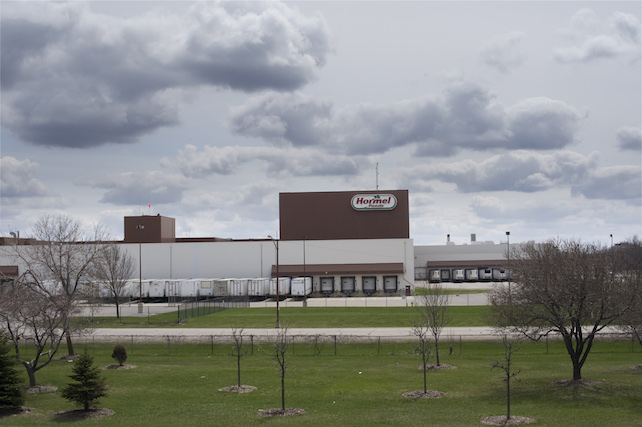
Each day, 19,000 squealing pigs enter the Austin, Minnesota, complex in unmarked trucks, while the finished goods leave in Hormel trucks.
Alec Soth/Magnum Photos
What no one knew then, and has gone unreported until now, is that, in the months prior to the announcement, QPP quietly sold an 80 percent interest [DC] in itself. The buyer, Blaine Jay Corporation, had incorporated in 2004, but this was its first purchase recorded with the Texas state franchise board (on November 15, 2007). Corporate documents [DC] list an accounting firm on the LBJ Freeway in Dallas as Blaine Jay headquarters and Kelly Blaine Wadding as president.
The shell had grown another shell.
The QPP parking lot is gravel, and on a day like the one when I was there—the first day of March, when the mercury had finally pushed above freezing and the glaciers of plowed snow were starting to drip and calve—it was muddy and rutted and pocked by potholes. At four, the sun hung blindingly bright in the sky, and the entrance to the fenced grounds was alive with workers flowing in and out: the shift change. The QPP workforce was mostly Hispanic with a smattering of Somalis and African Americans, all pushing through the narrow turnstile as I waited for the security guard to reemerge from his booth. Eventually the guard opened the door a crack, apologetically. “They are just ridiculously uptight about things like this,” he told me. Indeed, in more than three years since the outbreak, QPP had never allowed a reporter onto its grounds—until I visited.
Finally, Carole Bower arrived and ushered me toward the entrance. She was dressed in hospital white, down to her shoes. Even her manicured nails were tipped in white, and her hair had been frosted with highlights. Her demeanor, too, though not exactly icy, was officious. She was very sorry to have kept me waiting, she said, but “Quality Pork and Hormel take security very seriously.” She gestured toward the office entrance, ushering me away from a stream of workers climbing stairs toward the kill floor. They moved steadily past the laundry-room window, taking clean aprons.
Once we were inside a tight, private office borrowed for the occasion, Bower shut the door and closed the blinds. She sat behind the desk and spoke from a set of prepared talking points. She seemed taxed by the dilemma of owning up to QPP’s role in the outbreak without accepting culpability. I felt bad for her. But I didn’t know then that she’d served as one of the four directors of Albert Lea Select Foods [DC], another “co-packer” for Hormel in a nearby town—another company headed by Kelly Wadding, headquartered at the same accounting firm in Dallas, and, as of 2008, 100 percent controlled by the Blaine Jay Corporation. Shortly after that transaction, Select Foods, which then described itself as “an extension of Quality Pork Processors,” announced a $1.5 million expansion that dramatically increased capacity and added more than 100 nonunion jobs—many filled by an influx of Karen refugees from Burma, who were legal under asylum laws.
Bower seemed focused on defending the speed of QPP’s response to the outbreak and showing management’s deep caring for the affected workers. “When the public health department came on site, we had open meetings with all of the employees in our two big break rooms,” she said. “They took them off their work time, paid them for their time, and the president of the company and our HR manager and myself and anyone else that was involved talked to them, had interpreters, explained what was going on. We had weekly meetings just like that with everybody in the plant for the following four, five, six weeks.”
I asked why they hadn’t simply informed workers in writing, noting that the lunchroom held barely a hundred people. It would have taken a dozen or so meetings at each step of the process to inform all 1,300 QPP workers in the manner she described. Her calm reserve faltered.
“We had multiple meetings,” she said, growing flushed. “We would have the day hot side, the day cold side, livestock. We probably had four meetings in a row. Day and night. For weeks.”
Nevertheless, many affected workers didn’t know all the facts. Susan Kruse, who was at home and unable to work, didn’t learn of the outbreak until she saw it on the evening news. Emiliano Ballesta didn’t know how widespread the illness was until he arrived for a steroid treatment at the Austin Medical Center and found the waiting room filled with his coworkers. Back at work after another five months out sick, Matthew Garcia was surprised to discover that Dr. Lachance had ordered him, along with a group of fellow employees, put on light duty and referred to another Mayo Clinic neurologist.
Those who did attend the meetings, people like Miriam Angeles, remember the break-room gatherings very differently from Carole Bower. When Angeles spoke to me at Austin’s Centro Campesino with the cultural center’s director, Victor Contreras, serving as interpreter, she said management insisted that, although people from QPP had become sick, there was no evidence that the illness originated from inside the plant. The managers instructed workers to keep quiet until the company made a public statement. “We prohibit any comment about this,” she remembered being told. “Anyone who comments on this disease, you could lose your job.”
Affected workers were instructed not to identify themselves in the group meetings nor ask questions. In one meeting, however, a sick worker rose in a swell of panic to ask Kelly Wadding, “What’s going to happen with my health?”
Wadding, according to Angeles, said: “Sit down. We’re going to talk to you in the nurse’s office.”
After that, there were more meetings, but sick workers were afraid to speak out. They whispered in locker rooms. They phoned each other at home. They slowly figured out who some of their sick coworkers were, but when Wadding called a final meeting to announce that the mystery illness was under control, Angeles said the affected workers were too scared to say anything. And, though they were all in the UFCW, neither Local 9 nor the bosses in Washington took up their cause.
To this day, there is no agreed-upon number of QPP workers who were affected by the illness. The MDH conducted a survey [DC] and found 15. In his published study based on rigorous testing, Lachance says he found 21. Thirteen were sufficiently incapacitated to file workers’ compensation claims against QPP. The count is further complicated by the revelation that MDH reached out to the two other plants in America where pork brains were being harvested with compressed air, and some published reports include seven additional cases from the Indiana Packers plant in Delphi, Indiana, and one more from the Hormel plant in Fremont, Nebraska.
Angeles didn’t seek out other affected workers. She resolved to just do her work and keep quiet. She never complained, she told me, even though she claims that her supervisor never honored her doctor’s orders that she sit for 15 minutes every two hours. When the strong medications that had been prescribed for pain in her arms left her with blurred vision, the supervisor still refused to let her take a break. “No,” Angeles says she was told, “you have to keep working.”
In May 2008, five months after the MDH visit, an outside social worker, Roxanne Tarrant, was assigned to guide employees through filing workers’ compensation claims. (Under Minnesota law, filing a claim precludes the possibility of a lawsuit.) In a successful claim—which is not dependent on employment or immigration status—the injured party can receive wage-loss, medical, and/or rehabilitation benefits. Those benefits—which in a case like this could cost millions, mostly in medical claims—would be paid for by insurance; QPP’s insurer was an AIG subsidiary. However, a recent appellate ruling [DC] reveals that QPP’s policy had a $600,000 deductible for “Each Accident or each Person for Disease.” QPP argued that the outbreak constituted one “accident.” The court disagreed, making QPP pay $600,000 per affected worker, which could total more than $7 million.
As the workers began filing their claims, QPP offered Angeles and several others about $20,000 each as a preemptive settlement. But QPP’s offer required workers to forfeit medical benefits. Doctors were still determining whether workers’ nerve damage was temporary or long-term, whether they would ever be able to work again or faced permanent disability. The workers rejected the offer.
Days later, on the Monday morning after the long Fourth of July weekend, Angeles was told to report to human resources, where she was informed that there was a problem with her identification. Angeles, who’d been working under another name, knew she was about to be fired. Would she continue to have her health insurance? Would she still qualify for worker’s comp?
“They said, ‘That’s your problem.'”
Angeles’ voice turned soft, lost in that memory.
“I feel thrown away,” she said, finally. “Like a piece of trash. Before, I worked hard and willingly for QPP, but after I got sick and needed restrictions and told them I was in pain, they threw me away like trash and were done with me.”
Six months earlier, when Matthew Garcia was sent back to the Mayo Clinic neurology department, Dr. P. James Dyck explained to him that there was an “epidemic of neuropathy” that was affecting QPP workers—a newly discovered form of demyelinating polyradiculoneuropathy. Inhaling aerosolized brains had caused his body to produce antibodies, but because porcine and human neurological cells are so similar, the antibodies began destroying Garcia’s own nerves, as well.
The new disease theory made sense, except that, according to company officials, QPP had been blowing brains, off and on, for more than a decade. So why did workers fall ill now and not earlier? The answer is complex. First, in April 2006, the line speed increased from 1,300 pig heads moving down the conveyor belt each hour to 1,350. This speedup was slight, but it was just the latest in a series of gradual increases. “The line speed, the line speed,” Lachance told the AP, when recounting patient interviews. “That’s what we heard over and over again.” The line had been set at 900 heads per hour when the brain harvesting first began in 1996—meaning that the rate had increased a full 50 percent over the decade, whereas the number of workers had hardly risen. Garcia told me that the speed made it hard to keep up. Second, to match the pace, the company switched from a foot-operated trigger to an automatic system tripped by inserting the nozzle into the brain cavity, but sometimes the blower would misfire and spatter. Complaints about this had led to the installation of the plexiglass shield between the worker manning the brain machine and the rest of the head table. Third, the increased speed had caused pig heads to pile up at the opening in the shield. At some point in late 2006, the jammed skulls, pressed forward by the conveyor belt, had actually cracked the plastic, allowing more mist to drift over the head table. Pablo Ruiz, the process-control auditor, had attempted to patch the fracture with plastic bags. (To this day, Ruiz says he suffers from burning feet and general exhaustion.) Fourth, the longer hours worked in 2007 had, quite simply, upped workers’ exposure.
But Dyck, the Mayo neurologist, had some good news. He and Lachance diverged from the description of the disorder favored by the Department of Health and the CDC. All the doctors agreed that pig brains had triggered an autoimmune disorder. But MDH was calling it progressive inflammatory neuropathy (PIN), while the Mayo team rejected this name, because the doctors there didn’t believe that the disorder was progressive. Now that QPP had halted harvesting pig brains, Dyck explained, Garcia’s condition should improve.
But Garcia struggled to return to work for the better part of 2008. By fall, he still had burning in his feet, his knees clicked when he walked, and his bowel and bladder problems persisted. In November, Lachance found a “suspicious spot” on a nerve at the base of Garcia’s brain and would eventually diagnose it as a nerve-sheath tumor.

Austin is home to an influx of immigrants, seen worshipping at Queen of Angels church.
Alec Soth/Magnum Photos
Still, on December 5, Garcia passed a series of tests administered by doctors at the Austin Medical Center to see if he could return to work. But Lachance, who had the final say, was concerned. Garcia had quit sweating in his extremities, a clear indication of nerve death—permanent damage. Lachance emphasized in a letter to social worker Roxanne Tarrant that Garcia should only be asked to do sedentary work as he “has some mild degree of residual gait difficulty associated with spasticity, which would affect his efficiency of walking and fatigue levels.”
Garcia met with Carole Bower to discuss reassignment. He was taken to his new station, mere feet from the old brain station. Seeing the blood on the floor and the hog parts sliding by on the conveyor, Garcia started to panic. He was afraid that he would again be exposed, that his condition would worsen. He couldn’t catch his breath; his chest tightened. He begged to leave and called Tarrant. She secured him a different job, away from the head table.
QPP doesn’t have the “special worker” program for disabled employees that Hormel has. Garcia was assigned to a job in the “box room,” where cardboard shipping containers are prepared. It worked out okay at first, though Garcia often had to lift more than the 10 pounds that doctors had indicated should be his limit. But then QPP reassigned another box-room worker, and Garcia’s workload increased. Tarrant complained to nurse Bower, to no avail.
Even after his diagnosis, Emiliano Ballesta was reluctant to transfer to another place on the factory line. His job, removing sinewy cheek meat from the tight nooks of the skull (a job known as “chiseling”), requires more handwork than most tasks at the head table. In the era of Upton Sinclair’s The Jungle, workers used an actual chisel to pry open and dislocate hogs’ jaws, then hacked away muscles from the cheeks and temples. But today most factories use a mechanized jaw-puller for the brute work, and workers make precise cuts with a straight blade, honed to razor sharpness and handled with a chainmail glove. The skill required made Ballesta’s job one of the most prestigious and—at $13.15 per hour following a raise—highest-paying positions at the head table.
In the kitchen of his rented apartment in a house on the east side of the Cedar River, Ballesta turned the blade of a butcher knife over, checking both sides.
“You have to be sure there are no dents in the blade,” he said, as one of his sons translated. “Then you sharpen it against the steel rod.”
He slid the blade out and back along the sharpening steel in a fluid motion that made the knife hum and sing. During the early days of the new plant, veteran workers complained repeatedly about the introduction of mechanical knife sharpeners, replacing personal stones and steels used to hone and feather their knives. They insisted that the mechanical sharpeners never gave knives a proper edge, leading to more strain while cutting and eventually to carpal tunnel syndrome. Some, like Ballesta, continued to use their own sharpeners.
“The skin of a hog is very thick and the blade would wear out quickly. I had to keep sharpening it all day.”
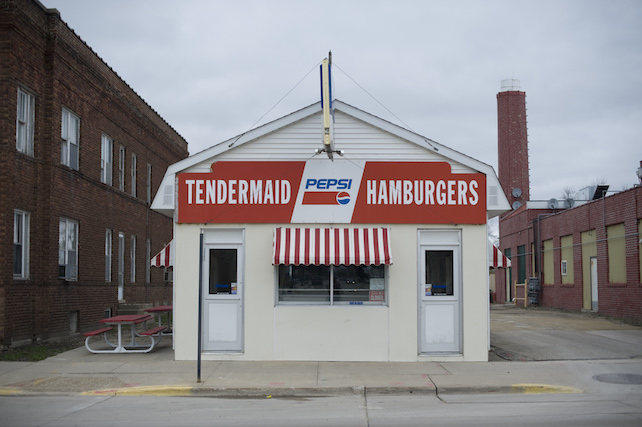
Austin is home to small-town Americana.
Alec Soth/Magnum Photos
Everything about him was commanding—from his trimmed mustache to his iron-gray temples. Once, I spotted him among the crowd of congregants arriving for Mass at Queen of Angels, his bright-red Western shirt pressed and perfectly creased, the sleeves buttoned to conceal the circular scar of a Whizard knife slash on his left forearm. Even on the day of that injury, he had gotten patched up at the Austin Medical Center and returned to finish his shift. It must have been nearly impossible to accept that something invisible—something he referred to always as “the infection”—had robbed him of sensation and fine motor function, turning what had been surgical skill into a fumbling hazard.
After his diagnosis, Ballesta tried other jobs: weighing and packing parts, running the circular saw that clips off snouts. He even tried a less-skilled job trimming head meat with the Whizard. But by March 2009, the tingling in his right hand had grown worse and left his middle finger completely numb. Ballesta was given lighter duty washing ears, then taken off the line altogether to work in the box room alongside Matthew Garcia. By May, Ballesta was back to chiseling, but his need for breaks jeopardized his ability to hang on to the job. Under his contract, he had to bid for the job—and the position was increasingly coveted by other workers.
Bower sent an email to Lachance about Ballesta. “Rather difficult,” she began. “He really likes the chiseling job and does not want off of it.” She explained that Ballesta had asked to return to chiseling full-time. But Lachance believed he would still need 15-minute breaks every two hours, something that Bower doubted could continue to be accommodated. Still, she wrote that Ballesta “is a very good and ethical man so wants to work hard and please his employer. Can we see how it goes for awhile?”
In July, Bower told social worker Roxanne Tarrant that QPP had been reviewing the job lineup sheets for the workers with PIN, and it was becoming increasingly difficult to manage their required accommodations. She asked Tarrant if Ballesta could possibly chisel cheek meat without taking breaks. Ballesta balked. He said that he still had terrible burning in his feet if he stood too long; he just couldn’t do it. On October 1, Ballesta finally gave in and requested to be put on cutting and cleaning intestines—despite a 20-cent-per-hour pay cut. He was dismayed but joked to coworkers that, after years at the head table, he would finally graduate to another station. That Saturday, October 3, would be his 15th anniversary at QPP. He called it his quinceañera, his coming of age.
But that Saturday, when he arrived at work, Ballesta was summoned to human resources. It was his last day at QPP.
Six months later, in April 2010, Matthew Garcia, too, was called in to talk to Dale Wicks in human resources. Wicks said that a man had been arrested in Texas; his name was Matthew J. Garcia—and he had the same date of birth and Social Security number as this Matthew J. Garcia. Wicks asked if his papers were his own. By now, workers—who had formed a support group that met weekly at Centro Campesino—had learned not to confess the way Miriam Angeles did, the way Emiliano Ballesta did. Of the 13 workers who had workers’ comp claims, six had been fired for working under forged or stolen identities.
“I told them, yeah, they’re my papers,” Garcia said. “I have my ID, I have everything.”
During his illness, Garcia had enrolled in classes at Riverland Community College, and his English was now good enough to get him by without an interpreter; he was not as frightened as other workers had been. Wicks warned that law enforcement was investigating, that they had already found records of Garcia’s information being used in five other states. Garcia insisted he didn’t know anything about that, that those people must have somehow stolen his information.
Garcia wasn’t fired—but in June 2010, his condition suddenly worsened. A new round of tests convinced Lachance that his condition was likely now chronic. “I think his symptoms will be long term,” Lachance wrote to Carole Bower, urging QPP to find a place for Garcia to perform light work—perhaps even a job in the office. “Hopefully some day his pain syndrome will gradually remit and his tolerance for physical activity improve but for the foreseeable future, especially concerning work-related activities, I think it is reasonable to assign some permanency here.”
Tarrant told me that she understood the difficulty that QPP faced in finding light-labor positions for the injured workers. “It’s a slaughterhouse,” she said. “There really are no light jobs.” Still, she was dubious of the claim that Immigration and Customs Enforcement just happened to be investigating so many affected workers whose doctors had recommended lighter duty. (Indeed, it’s not clear ICE did.) “When the first firing happened, I thought it was interesting,” Tarrant said. “When the second, then the third happened, I thought it was fishy.”
My last morning in Austin, I drove to QPP for a final look. I parked across the road from the plant and rolled down the windows. It was still cold, the snow piled along the sidewalks turning gray and pitted. As the day shift started up, the smell was unmistakable: fresh pig shit and baking ham. Along the access road, marked Hormel Drive, 18-wheelers came barreling in, pulling livestock trailers. They took the corner through the chain-link gate and reversed into the loading docks, all but concealed by that barrier wall. But as each new truck arrived, I could hear the beeping of the backup warning, then the rattle of rear doors opening. And then there was the sound of sizzling electric prods, the clatter of cloven hooves on metal grating, and the guttural, almost human, screeching of hogs.

The check window at the UFCW Local 9 office.
Alec Soth/Magnum Photos
I dialed my cellphone and once again got Kelly Wadding’s voicemail. Weeks later, when I finally got him on the line and said that I had been struck by how many of the workers affected by PIN had turned out to be undocumented, Wadding plunged into a rambling monologue. “I know where you’re headed and I’ll tell you right now: Anybody that’s contracted PIN or any other illness or injury at work, we never, ever, ever go back and check their documentation.” I could hear his fist bang on something hard. Never, ever, ever. Bang, bang, bang.
“They’re still getting paid work-comp benefits; they’re still getting paid their medical,” Wadding insisted. “We have no desire to send these people down the road.”
What I didn’t know at the time was that Wadding was in the final stages of negotiating a settlement with up to a dozen employees who had filed workers’ comp claims. After attorneys’ fees, each received $12,500, a half-year’s pay. Matthew Garcia, because he was deemed to have been permanently injured, got $38,600. As a condition of the settlement, he would no longer be employed at QPP. “I felt pushed into it,” Garcia told me. “My attorney said, ‘If you don’t do it, you’ll end up with nothing.'” He has used the money to pay for more courses at the community college, but it’s going fast. He asked me not to use his real name for this article, fearing it might hurt his application at McDonald’s.
After leaving a message on Wadding’s voicemail, I saw the QPP security guard trundle out to his truck and begin circling the block, driving by again and again. But he couldn’t touch me. I was on a public street, next to Horace Austin Park with its clear view of the Cedar River. I sat and watched as evidence of our national industry and know-how arrived by the truckload. Our whole history of conquering the West, industrializing agriculture, and turning hog slaughter into a “custom meat operation” arrived at QPP’s door.
I once asked Dale Chidester if he ever marveled at the sheer scale of it—the relentless pace required to process 5 million hogs a year. He laughed. You don’t think about such things while you’re working on the line, he explained; mostly you try not to think about anything at all. Your muscles remember and repeat. “It’s like tying your shoes,” he said.
I rolled up the windows and turned the key in the ignition. More than 19,000 hogs were processed at QPP that day. It was like any other day.
Additional reporting by Joe Kloc.
